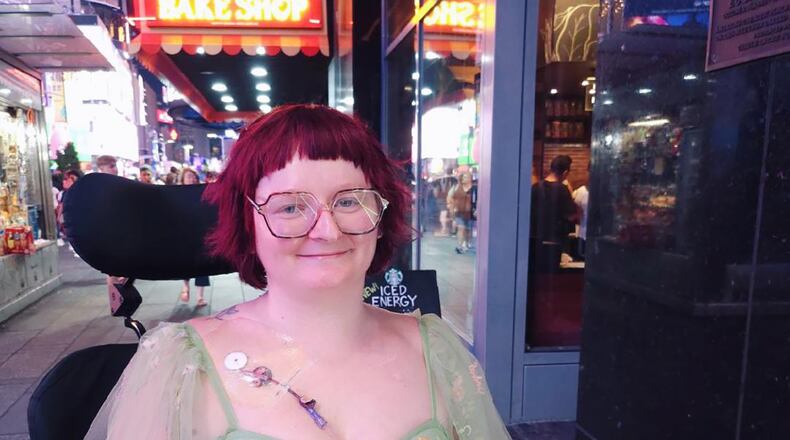“I didn’t have any accommodations,” Elson said. “But I was in honors classes and show choir and I worked two jobs during my senior year.”
While in college in 2016, Elson, who identifies as nonbinary, suffered a traumatic brain injury after sophomore year.
“I was double majoring in accounting and finance,” Elson said. “I had a long board accident. I fell and had multiple subdermal hematomas.”
After a hospital stay of two weeks, Elson began to have memory difficulties. The diagnosis was a skull fracture and severe concussion, and Elson couldn’t remember recent events, such as phone conversations and television programs watched the night before.
“Doctors didn’t know anything,” Elson said. “I started learning from that experience and started questioning other symptoms I’d had my entire life.”
At age 20, Elson finally received a diagnosis of Ehlers-Danlos syndrome, an inherited disorder that affects connective tissues. People with this condition usually have overly flexible joints and fragile skin.
“I started making YouTube videos about brain injury,” Elson said. “A friend knew someone who had it (Ehlers-Danlos), but I didn’t think it was related to me. Everyone presents differently.”
Elson admits that it took them years to tune into what was happening to their body. In this case, the syndrome caused wound healing issues, hypermobile joints and severe, chronic pain. Elson deals with partial stomach paralysis and severe spinal disability. They also suffer from Postural Orthostatic Tachycardia Syndrome, a heart condition that causes dizziness and disorientation.
Elson tried to return to Wright State University and finish college after the accident. With a heavy case load and a job prior to the accident, Elson intended to go back to the same schedule.
“I tried to return in the spring of 2017, but that didn’t go well,” Elson said. “I couldn’t do it physically or mentally.”
With worsening symptoms including frequent, severe headaches and neck pain, Elson struggled to function. A diagnosis of spinal instability in 2017 sent Elson to a neurosurgeon. In 2018, Elson had surgery then moved to Fairborn and got a roommate to help with their care.
“I still had severe pain, but I was no longer in danger of dying if I had any accident,” Elson said. “I ended up recovering at my mom’s home in Tennessee and found a new doctor that specialized in EDS.”
Between 2019 and 2020, Elson focused on recovery, health, dietary changes, physical therapy and positive affirmations. Finally diagnosed with autism in 2019, Elson began a constant schedule of appointments.
“In 2020, I was actually doing good when everyone else was doing bad,” Elson said. “I stopped going to all those appointments and my symptoms started to get better.”
But that improvement was short lived, as Elson suffered a severe cerebral spinal fluid leak and was completely disabled and bedridden for more than a year. And it was during this time, while Elson required the care of aids, that they discovered how to advocate, not only for themselves but also for other adults with disabilities.
“I joined a Facebook group and got connected to others working in advocacy,” Elson said. “I attended an art advocacy workshop, and we turned artwork into postcards to send to care workers.”
Elson enjoyed the workshop, and this marked the first time they had connected with a local disability community. This inspired Elson to do more, and they started watching Disability Rights Ohio (DRO) hearings to learn more.
“I thought that’s really what I wanted to do,” Elson said. “I attended the Ohio Olmstead Task Force and in January of 2023, I went to meet with legislators for the first time.”
In May of 2023, Elson testified in front of the state Medicaid committee about the nursing crisis and low wages. The task force members compared Ohio rates with those in other states and armed with that information, asked for higher rates for nurses working in community-based home services. Today, Elson, now 28 years old, cochairs an Olmstead Task Force work group focusing on the direct care crisis in Ohio.
Elson’s disabilities are mostly genetic and were overlooked due to lack of knowledge about EDS and the many family members with autism and ADHD. Because of this, they hope to help others get timely diagnoses and help when they need it.
“It is impactful to connect with my community and to get people to better understand disabilities and caregivers,” Elson said. “This is a more direct way to make a difference, and I feel like I’m making change for people with disabilities.”
About the Author







